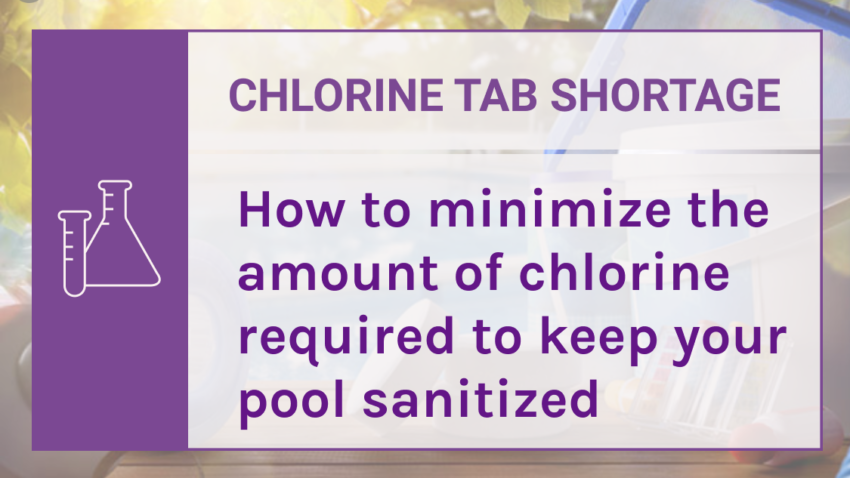As if 2020 wasn’t hard enough on everyone, now pool owners are bracing for a shortage of chlorine tabs and pool equipment, some say through 2022.
Due to several events, owners should expect limited availability and price increases on trichlor tabs and pool equipment in general as pools open across the US.
The shortages are due to a series of unrelated events that came together to make the perfect storm.
- A fire in August of 2020 that destroyed a manufacturing facility that was responsible for supplying ~80% of the trichlor tabs and dichlor shock used across the country.
- The 2021 Deep Freeze Snowpocalypse that damaged countless pools and equipment in more than 10 states and resulted in a run on repairs and parts.
- COVID wreaked havoc on manufacturing and supply chains.
- Everyone and their brother decided to get a pool in 2020 and 2021.
Remember the great toilet paper shortage of 2020? Well it looks like we may be headed down that road again now with chlorine tabs. People are beginning to panic buy and that is only going to make things worse for the existing supply.
Fortunately, unlike toilet paper, there are alternatives to trichlor tabs that pool owners can turn to rather quickly and there are also things that can be done to minimize the amount of chlorine required to keep your pool sanitized.
Let’s look at what you can do to keep your pool clean and clear during this perfect storm.


Alternatives to trichlor tabs
Although there are different types of tabs, it’s important to understand that you can’t simply swap from one tab type to another because mixing different types of tabs can cause an explosion and destroy your chlorine feeder or result in personal injury – so DON’T do that.
Let’s look at some other options that will help keep your pool from turning green.
Liquid Chlorine (Sodium Hypochlorite)
Let’s start with liquid chlorine as it turns out to be the cheapest and easiest option. A lot of people use liquid chlorine for pools and it can be purchased from local pool stores, big box stores, and local chemical supply companies very easily.
Liquid chlorine for pool care has immediate advantages over pucks as it doesn’t have additives like stabilizer and calcium, which means that you don’t have to worry about a build up that can negatively impact your water chemistry.
A liquid chlorine injector can give the same convenience as a tab feeder. There are a few options such as homemade solutions using containers and pumps for those owners that are more mechanically inclined and electronic systems that connect to your pool control panel (not all models mind you.)
However, our favorite is the HASA Liquidator chlorine injection system because it is much simpler to set up and use, and it makes liquid pool chlorine just as easy to use as tabs.
Salt Water Chlorine Generators (SWCG)
SWCG systems are also good solutions, but they are a bit pricey and may not be for everyone. SWCG pools are relatively low maintenance for sanitizing water as they generate their chlorine from salt and salt is readily available.
Ionizers, AOP, Mineral, Ozonator
All of these options will also be in higher demand, and are a bit expensive as well. It’s also important to understand that even though these systems reduce the amount of chlorine needed, they do not completely eliminate it so they aren’t an “alternative” to chlorine.
Chlorine alternatives
- Biguanides – BAQUACIL® is a chlorine alternative, but it’s quite pricey and can be a challenge to manage if you let the water get out of balance and have an algae outbreak.
- Bromine is another alternative, and it requires an oxidizer to activate after adding. However, it can be confusing and challenging to use as you can use chlorine to activate it, not as easy as the 3 inch chlorine tablets.


How to reduce the amount of chlorine you need
There are several things you can do physically and chemically to reduce the amount of chlorine your pool needs. A little effort can go a long way towards helping your chlorine keep your water clean.
Lending a helping hand to chlorine
- KEEP YOUR WATER BALANCED! This is the most important thing you can do to prevent the need for additional chlorine. In particular, make sure your pool chlorine stabilizer is within range as it prevents your chlorine from being destroyed. It will prevent cloudy water, algae breakouts, and the extra effort to clean up afterwards.
- Keep your skimmer baskets, pool floor, pump basket, and filter clean. The more foreign material you leave in your water then the more chlorine it takes to combat it.
- Run your pump long enough to make sure that you are filtering out contaminants and also circulating the water enough to get proper sanitation.
Bringing other chemicals to the party to help
- Phosphate Remover – algae use phosphate as nutrients and if you have high phosphates the algae can multiple and put a larger strain on your chlorine.
- Minerals – mineral solutions such as PoolRx, Nature2, and several others can help reduce the demand on your chlorine by combating algae and allowing your chlorine to focus on other organics and bacteria.
- Algaecide – algaecide can help your chlorine be more effective against algae and therefore lower the demand and prevent outbreaks or help recover from them.
- Borates – borate is helpful even without a chlorine tab shortage and it has several benefits, including being an algaestat and helping keep the pH from bouncing.
- Enzymes – enzymes attack things like oils and lotions and help eliminate them so that chlorine can focus on algae and bacteria.
No matter which solution you choose, Sutro’s advanced machine learning and treatment recommendation engine (TRE) can help you reduce your pool costs and keep your water clean and clear.
Sutro monitors your water chemistry and will tell you when you need to add chemicals and how much you need to add based on your pool and the type of chemicals that you use.
Neither heat nor rain nor the 2021 chlorine tab shortage can keep Sutro from making you love your pool (or spa) again!

